Royal Enfield Continental GT : First Ride
Straight modern blast from the past seems an anachronism but it best illustrates how well Royal Enfield has conjured up its first all-new motorcycle in over 60 years! Adil Jal Darukhanawala swings a leg aboard one of the very first of these biggest of big Indian singles to put the spanking new and absolutely smashing Continental GTs thru its paces at Brooklands, the spiritual home of British motorsport and beyond. Say hello to a delightfully modern take to classic motorcycling charmingly packed with useable performance for the now and here
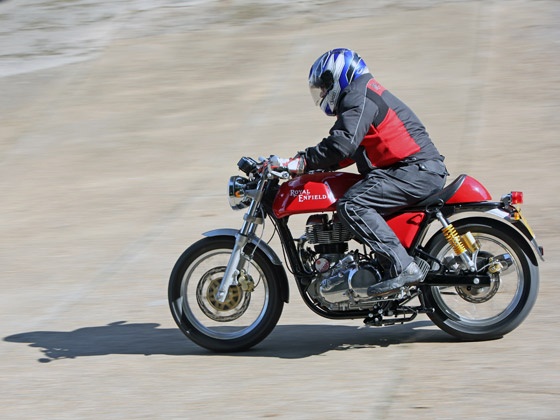
It couldn’t have happened any other way I thought for here I was hustling the biggest bore single ever made by Royal Enfield on the cobbly B-roads from London on to the hallowed banked circuit at Brooklands for a press conference to herald the first genuinely all-new motorcycle to sport the Royal Enfield badge. It was different to begin with but just so very apt for a new machine that combines character traits from over half a century ago with handling and performance for the present in a contemporary form that is delightful, very useable and highly enjoyable. If I have given the game and the objective away right at the very start it was unintentional because this is what the new Continental GT will do for not just an Indian but a global audience which for the most part will be all new as well as spanning the genre from classic oldies to BABs (born again bikers), from the young hot shots to the commuter-inclined, from those who love motorcycling for the joy of being one with the machine and delight in soaking up the power pulses from a large single-cylinder thumper with probably the best handling characteristics ever for a bike which made its name with the simple statement of intent: “Built like a Gun.”
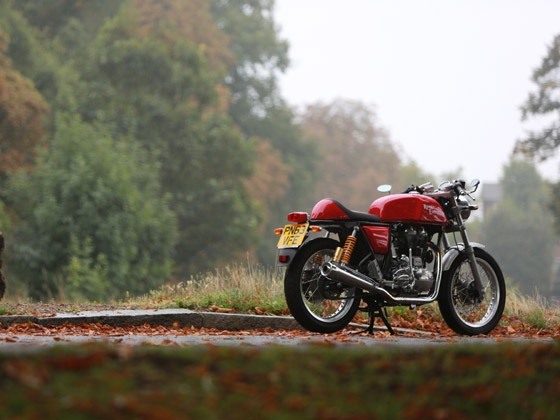
The sort of launch that Royal Enfield did was right in character for a bike that was in the making for over a decade but no one quite knew that! Let me explain. Ever since Siddhartha Lal was pitched in at the deep end to head Royal Enfield after Eicher bought it over, the biggest objective was not just ensuring the marque’s survival but the way to do it. So while we have seen the quintessential Bullet get better metallurgy, more efficient manufacturing processes, improved build quality, and a subtle shift away from the dudhwala mentality, we could read that with every passing phase (both successful as well as awful as Sid and his team are the first to admit) the company was learning. From an old management to a completely new younger lot the transformation as underway, led from the front by Sid who had no hesitation in pulling in the right brains to help him on his quest to turn the firm around.
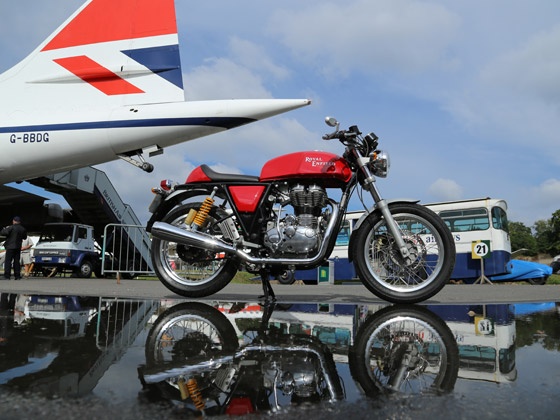
Understanding the Redditch heritage
While there were tremendous learnings coming its way the most important aspect which dawned on Sid and his band was that they had a brand that had character aplenty but more than that the brand also incidentally happens to be the oldest British motorcycle marque yet in existence in the world! This heritage and legacy is something which has been an ongoing one even after Royal Enfield ceased to exist as an entity in the UK in 1967 but the Indian arm soldiered on. Triumph may be back on the scene but this is an all-new entity with no connect to the old firm except bearing the original firm’s logo and with bikes that are well, very much contemporary ‘Japanese’ in character and configuration. There are attempts to revive Norton but yet again these are contrived and this is exactly where Royal Enfield has that vital edge. In fact if one has to make a comparison then it is only Harley-Davidson which comes close to rivalling Royal Enfield, both having started in the early years of the last century, the British marque was rolling out bikes a year earlier than its Yankee rival. Also Harley-Davidson has stayed true to its trademark vee-twin engine layout and continues in this vein to this day while having dabbled with small singles and twins over its 110 year plus history. Now if you are wondering whether Enfield India as well as Royal Enfield also did other bikes then yes it did scooters, small 125s, 150s, 175s, 200s and also 35cc, 50cc and 75cc mofas, mopeds, and scooters to boot, with such evocative names as Crusader, Prince, Mini-Bullet, Mofa, Fantabulous, Zundapp, et al. So the model mix was heady but inconsistent before the Eicher era but once Sid and his team got to grips it has been the push-rod single cylinder Bullet engine which has predominated their thoughts and redoubled their efforts to take this unit further.
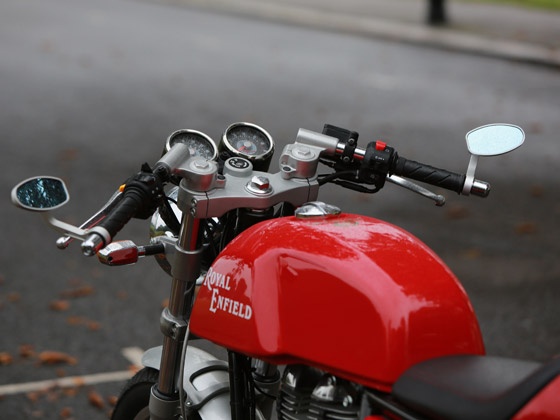
Making ‘Built like a Gun” relevant in the Indian context
The team had to battle massive adversity because to begin with it just didn’t have the wherewithal to take on the engineering challenges mandated by the emission regulations. So while lean burn engine tech was the “easier” approach to keeping the old single relevant, the manufacturing process was also being given a once over. The latter took more time but what was important was while the basic building blocks were being strengthened, simultaneously the firm began to learn more and more about its place in history, its relevance among British motorcycling and also its place in the Indian psyche. From one-off nostalgic Brits taking to the Bullet to a gradually increasing bunch of bikers who thrived on unhurried classic motorcycling, the Bullet started making inroads in the minds of European, American, Australian and Japanese bikers while continuing to stay relevant in India.
From lean burn engine tech to just about make the engine emission norms for Euro III and then on to thinking about newer better versions of the original aggregates, the Bullet started getting more relevant and along sides that the firm began to think about moving away from the classic bike config. There came in the Thunderbird cruiser, obviously Harley was the inspiration, and this suddenly opened up a whole new vista for bike and its users who craved the long distance biking bug. From here on we had a five-speed gearbox and lest I forget one of the most important character detail change to date – the move away from the right foot gear shift to the universal left-foot gear actuation. This helped open a new and larger enthusiast base for Royal Enfield and when the firm began to dabble with more engineering challenges, the move to incorporate the gearbox within the engine casings resulted in the UCE or unit construction engine. The internals were revised to the extent the reciprocating masses could be without much differentiation barring better material and machining to give good balance and friction reduction. Electronic fuel injection was inevitable given even stricter emissions and suddenly we had a better Bullet, a more in sync with character British machine but conjured up in India. The Bullet Classic as this bike was badged has been one of the big block-busters for Royal Enfield and along with it came the move to an all-new state-of-the-art manufacturing facility at Oragadam near Chennai where the difference is absolutely discernable – the new Classics from here are even better made, finished and put together than what Tiruvottiyur was ever able to!
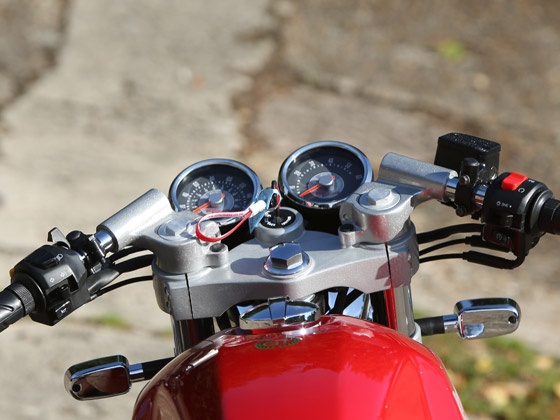
Fritz Egli shows the way to power without losing control
I must now move on to a couple of more detail intrusions into Royal Enfield’s recent history to understand the genesis of the Continental GT. The first was all about performance being asked of the Bullet 350cc lump and all of it was from European customers. Enter the guru of grunt, the legendary Swiss motorcycle turner, race-bike constructor and record breaker Fritz Egli. He was one of the very first who knew the way to tackle the Bullet and make it perform was not just to extract more from the engine but also to devise an all-new frame. The Egli approach resulted in a host of engine capacities which the Swiss ace did all by himself – there was a 535cc motor as far back as 1998, and if that wasn’t enough there was also a 652cc mill as well. Both these engines were carburetted, had specially forged pistons, con rods and a crankshaft completely machined from a solid billet. The engines were powerful and reliable and for small runs the precision approach from Egli was the way to go. In fact, to give due credit to Royal Enfield, Sid and his team played host to Fritz Egli who visited India and helped share his thoughts on how to go about nostalgia motorcycling.
Just as important as the performance hop-up was Egli’s bid to tame the headshake and the wooliness of the standard Bullet chassis which at anything above 90km/h was a handful. It wasn’t just about suspension componentry which could only go a bit but not completely eradicate the shortcomings of the chassis. He devised an all-new backbone frame for the Bullet into which his 535cc and 652cc special engines were housed. They were a massive improvement over the single down-tube chassis into which the large cast iron lump was hung – a stressed member as in the original design. Be that as it may but the first two major details to try and tame the Bullet did emerge from the fertile thought process of Fritz Egli, yours truly being privileged to have put these bikes through their paces in Switzerland over a decade ago.
Showing the way forward at Auto Expo 2010 and 2012
Fast forward from there on to the Pragati Maidan, and on to the Royal Enfield stand at the 2010 edition of the Auto Expo. Among the bikes there was a concept cafe racer which was perfect as regards the direction which hinted at the next model for the company. However the styling was odd-ball and I had no hesitation in stating the obvious. However the direction as spot on and unwitting as it sounds this was what got many excited about as well. Buoyed with this response and with a great deal of interaction with many enthusiasts the world over, Royal Enfield sprang a surprise at the 2012 Auto Expo by displaying the first prototype of the Continental GT which yet went by the Cafe Racer concept name. Finally there it was, just the right drool machine with the proper ingredients in the exact measure, bringing classic trait bang up to date in contemporary times. Of course it wasn’t ready as yet but the proportions, aggregates, style and that hint of performance and excitement were all evident. From there on began the final race to develop, hone and perfect the machine that emerged as the Continental GT in England last month.
The original Continental GT and its significance in RE history
And before I get to the hub of the matter having tried to register the context as well as the genesis behind its development I must hark back to the original Continental GT that was to prove the downfall of the original company! In 1965, Royal Enfield built a small 250cc single-cylinder sports bike which was christened the Continental GT. The bike was very peppy and the firm which till then was on an even keel as regards financial well being suddenly threw caution to the winds and decided that this bike had to be developed over all else so as to take the fight to the predominantly Oriental rivals. Sadly too much time, money and effort was put into this machine and the management took their eyes off the other production models and the come went bust, shutting shop for good at Redditch in the UK in 1967. By then about five to seven complete bikes were built out of a total lot of about 50 kits put together at the works. Almost 45 of these bikes survive and are prized machines among the classic bike aficionados the world over and in fact it was the last sporty Enfield ever. As such it is not known whether the significance of the bike was understood in the right way or not by Sid Lal and his team but surely the historic contrast to this bike and the new Indian-designed and developed Continental GT couldn’t be more evident.
And on to the renaissance….
Time then, to zero in on to the smashing piece of sporty motorcycle that the new Royal Enfield is! Let’s start by taking in the style and the stance of the machine. It is a thought process that marries some of the best loved design cues of British singles and race bikes of the 1960s, packages the whole mechanical milieu into one devilishly handsome motorcycle with the right proportions, the right bits and bobs, the perfectly crafted cycle parts and the right embellishments in equitable measure so as to deliver massively. As Sid Lal himself goes on record in our interview (following this feature) that the new bike is about the right bits and more, the tasteful outcome of so many aesthetic, dynamic, mechanical and esoteric performance and smile-inducing treatments makes this the authentic motorcycling equivalent of the joie-de-vivre spirit.
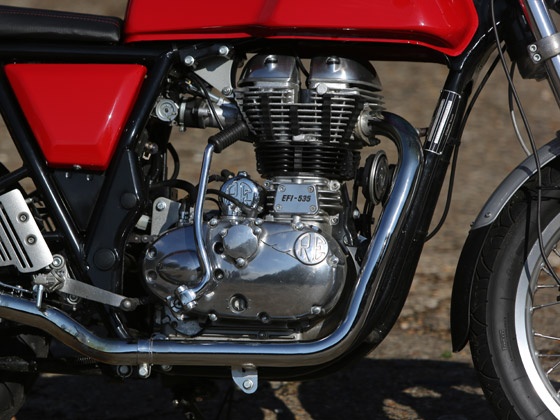
Egli-inspired engine but RE-built like a gun!
At the heart of it all is the engine, now bored to 535cc just as first hinted and made do-able by Fritz Egli over a decade ago. However while the cubic capacity hike is all about Egli showing the way, the rest is all Royal Enfield and its engine team for the present. No, that’s not entirely correct for it is also future proof to a great degree, being able to meet emission norms higher than what are in force today. Engine dimensions come close to an all-square bore and stroke, the exact readings being 87mm x 90mm to deliver an exact 535cc displacement. This is just a 3mm hike in the bore from the standard 499cc UCE engine that does duty in the Bullet Classic but there are strengthened internals, especially con rod and the bottom end. Much the same thought has also gone on the top end where it all matters, with uprated valves and valve springs and a tuned inlet tract for the Keihin EFI to do its job. The fuelling is critical for a big long stroke engine and even with the inclement weather we experienced in England, the Keihin-induction on the engine made it ‘carburette’ cleanly for want of a better word! Completely new ignition maps have been designed for the engine and while power is upped by just 2 bhp from the 499cc Bullet Classic mill, the revvability of the machine to just around 5400 rpm is laudable for such a big pushrod single. For the record the engine develops 29.1 bhp at 5100 rpm and while that’s just not enough for those louts whose biking preferably on one wheel alone, this is more than enough given the nature of this beast. Having 44 Nm of torque made at 4000 rpm is the perfect shot in the arm for the pilot to exploit the right sort of gearing to enjoy his biking.
The basic architecture of the engine is one of the visual delights of the machine and in an all-aluminium buffed finish contrasting with the blackened cylinder block fins continuing in the crankcase casings, this is one evocative single cylinder engine that is yet as modern in its classic overtones as it harks down to Brit bike heritage. The exhaust system is another piece of tuned and turned art, so very much a key aesthetic detail of cafe racers of yore. I loved the bent pipe and the way it goes down and runs parallel to the road before swinging up in rakish delight to a finely crafted megaphonic-exhaust – easy yet sporty to the eye and performs with aplomb. The only hiccup here is not finding that spaced out exhaust note so endearing of a Bullet but in its place comes a muffled roar that speaks a new sound language.
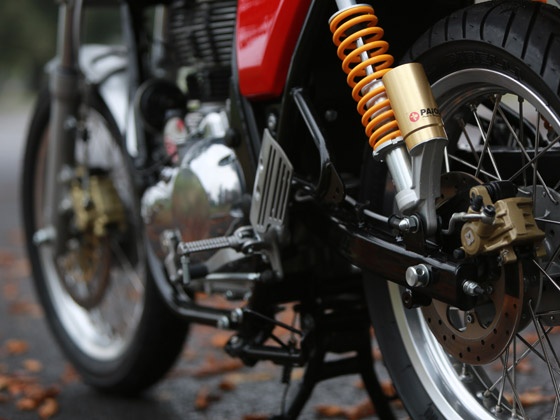
Enfield’s version of the ‘featherbed’ courtesy Harris Performance
This is the biggest departure from the Royal Enfield norm and it is strange that it should have taken so many decades to get this bit of chassis right. One of the greatest and best handling of British bikes in the 1950s and 1960s was the Norton which developed the double-downtube frame that was copied by almost every other bike maker. Born out of racing and first fitted to the Norton Manx Grand Prix bikes, it was the great TT champion Harold Daniell who said that it felt like he was riding a feather bed after his first stint upon using such a frame. Norton’s featherbed frames went on from GP bikes to road going tackle like the Dominator twins and then were used in the Triumph-engined Tritons and many others.
Royal Enfield were seized of the handling characteristics needed for a sporty motorcycle with added zest and the old single down-tube, stressed member engine was too weak and old hat to do the job. A double-downtube chassis it had to be and thankfully the way to do that saw them head to Harris Performance, one of the biggest names in motorcycling and wizards of chassis dynamics and engineering. Steve Harris learnt his craft not just in making stock standard machines progress to even higher performance with his frame technology but the racers for the Isle of Man TT benefitted massively from his stiff chassis that helped deliver neutral handling while soaking in the bumps and the jumps on the fabled Mountain course on the magical isle. If that wasn’t all, so many GP racers turned to him to sort out the handling woes on their fast Japanese tackle, from Yamaha TZ250 and 350cc campaigners to none other than the likes of 500cc World Champions Barry Sheene and Phil Read who got Harris to redesign the frames of the 500cc square-four-engined Suzuki RG500s to make them competitive and winning! In fact, Sheene’s XR75 version of the Suzuki was a complete Harris effort as regards chassis and the double World 500cc Champion benefitted from this as did many others down the line.
So what we get is a tubular down-tube double cradle strongly gusseted where it matters (at the headstock and the swing arm pivot) yet strong and rigid into which sits the massive cast iron engine. In one fell swoop this bike has turned the clock back, making the reverse journey from an old aged dowager back to youth in a certain manner which everyone will admit is most welcome! No more wobbly wiggles at speed and with enough flexibility in the mounts, the vibes have been kept to a minimum. With the new frame have come revised new suspension and cycle parts, all of them bringing the package bang up to date as regards dynamic ability. So we get all new 41mm dia stanchion front telescopic forks (made by Gabriel) with the right steering rake and trail while at the rear there is an all-new rectangular section swing arm which works with twin Paioli gas charged shock absorbers with piggyback preload adjusters. The suspension units not just look the part but behave as well and lend their own to the overall aura of the machine. And to top it all, the finely crafted front fork brace is both form and function personified as we shall see going forward.
It is also to Royal Enfield’s credit that they haven’t skimped on the essential bits whatsoever and whomsoever the eye roves on this bike. The front disc brake is a 300mm dia Brembo unit with twin-piston calipers while at the rear a smaller 240mm dia disc brake with single pot calliper is employed. The braking system is also capable of going to ABS-adoption and this should follow in a year’s time. So many times I have seen bike makers go the whole hog but falter when it comes to the boots and the structure they are wrapped around but on this front again there is positive thought and treatment. The alloy-wheel rims are virtual works of art with straight laced spokes and I am sure that classic bike aficionados will flock to RE dealers in India to get a set for their old Nortons, Triumphs, BSAs, Velocettes and the like, as long as it is 18-inch stuff their bikes came with! These superbly crafted wheels come wrapped with top notch Pirelli Sport Demon tyres (the front sporting a 100/90-18 56H unit while on the rear is a 130/70-18 63H tyre). The underlining theme here is that Indian tyre makers need to get ready to design and deliver the right rubber for the latest generation motorcycles and even the likes of MRF have to step up their act in this vein. After Bajaj Auto with the KTM 390 which comes only with Metzeler M5 Sportec rubber, Royal Enfield is the second Indian bike maker to go for the right tyres so as not to devalue the performance aspect of its motorcycle.
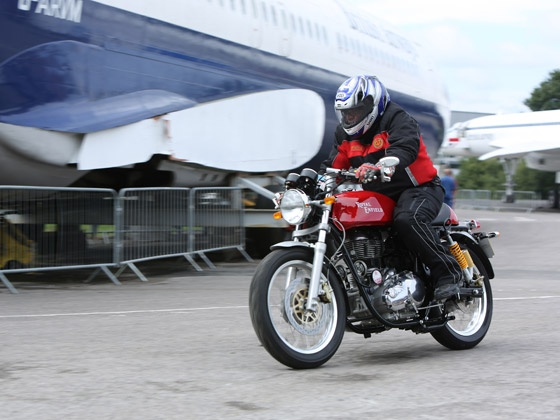
Stylish & chic neo-retro design
In this issue I have made many a mention of “if it looks right, it invariably is right” and this dictum holds massively true for the Continental GT. In fact, just the name is what is borrowed from Royal Enfield’s heritage while the structure and the form could well have been inspired from a Norton or a Velocette! The form and the stance as well as the detail has been the work of Xenophya Design which has been instrumental in styling some of the more recent Triumphs. Mark Wells of Xenophya Design worked with Royal Enfield’s very own S Sivakumar to get the form and the proportions right and what once gets is a slim and sexy motorcycle with enough drool appeal to make many go weak at the knees. The slimline tank is a work of art with superbly sculpted knee recesses to hug the tank in Mike Hailwood style while swinging through corners and that finely crafted single seat with bum stop displays contrasting stitching to hint at a period in time where such details were de rigueur.
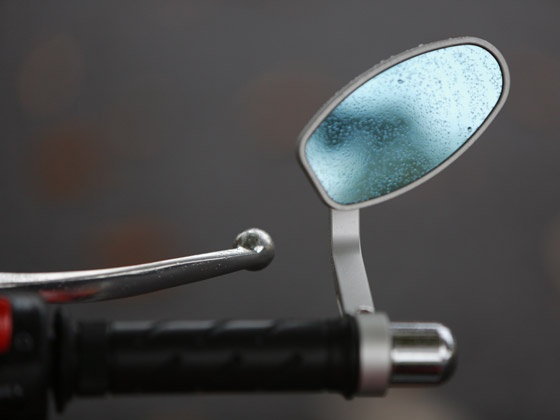
The attention to detail is faultless and cases in point are the front and rear mudguards, stylishly sporty and with black extensions that are so sanitary and cool. Even the period tail light is delectable as are the thin slim line rectangular turn-signal indicators. If you want even more proof of the top notch craftsmanship take a look at two items and prepare to keep yourself in check from way too much drooling. The first is the Monza-style flip-up fuel cap lid, something so very much a period delight yet so much in keeping with the bike’s character. The second detail worth mentioning are the twin triple clamps for the front forks, they are also a work of art and with the new clip-on handlebars, they help exude a certain gravitas which no Royal Enfield bike ever had in such measure. Move on to the grips and the levers and they are in keeping with the overall high on tactility and delight theme though I would have loved to see adjustability on the levers.
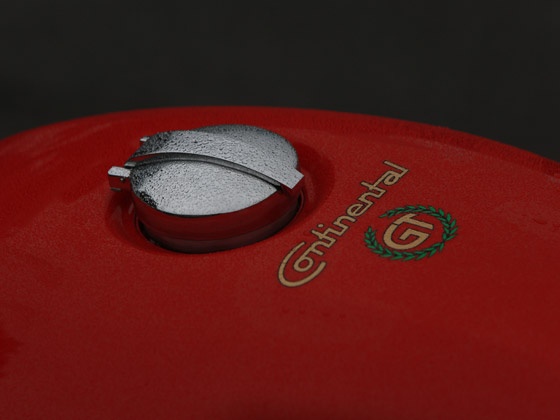
The fully-chromed headlamp is perfect and in sync with the retro-faced dials of the twin pod instrument cluster (the dial faces seem a rip off of the venerable Smiths instruments of top notch two-wheeled Brit rabble rousers of the 1960s but who cares when they work so effectively here!). All the bikes we had to ride in England came equipped with the stylishly small and very ineffective (for most) rear view mirrors fixed on the bar ends. I was comfortable with them only for the reason that I had spent a good deal of time adjusting them for my riding stance but on the handlebars there is provision for proper upright rear view mirrors which I think will be the OE norm. And then there are the grooved footpegs replete with classy linkages for the gear shifter and rear brake lever on either side of the bike. In true sports bike manner the chain is exposed and even though the bike comes with an electric starter, a kick lever is standard fitment! The Continental GT also comes with a main stand as OE (no getting away from it as yet) and also with a side stand which is hooked up to the engine management system in not getting the large thumper to fire if it hasn’t been pulled back. Nice thought this because I doubt any Brit bike of its time ever had such a detail!
On the road and swinging it from Ace Cafe to wherever…
The first thing which gets you is the form and you just want to go round and round the bike to take it all in, the sensory experience being positively overwhelming. The bike hints at a fairly easy order without in the least bit being intimidating even though the sporting pretension is there to hint at something beyond a Bullet. And it is here that it succeeds, a first move away from the venerable produce from Madras/Chennai (insert what you like and feel comfortable with) in making for a whole new type of motorcycle, back from the dead (if it is Brit single cylinder tackle you lust after) yet so very much a welcome breath of fresh air away from hyper bikes and easy paced motorcycling with just about 150km/h capability.
While it might have a new chassis with thoroughly modern suspension bits and cycle parts, the wheelbase is yet the same at 1360mm but then that’s all one can get to sharing with the Bullet. The weight distribution is positively inclined for the chassis and the suspension to deliver the long legged torque from the engine and once on the move the rock steady ability of the chassis filters through within seconds. Not just that, the fine steering makes its presence felt and you know that you are riding a prized stallion rather than a workhorse. The absolutely firm yet pliant ride is a revelation and the faster you go the better it gets as we found out when nailing the throttle to the stop on the motorway blast from Box Hill to Brighton. In severe head wind and riding flat out for almost 36 miles I had the Continental GT on song and she handled like a dream – no weave from the chassis, no head shake woollies to induce a tank slapper and enough poise and grip to keep it all so very planted yet with the throttle wrung to its max. Suffice to say no Royal Enfield in history has ever handled better!
Heck even from the ride out from Brooklands to Box Hill through so many legendary B-roads with tight turns, fully hedged sides and that classic British weather, the Continental GT was magnificence personified in its manners. Even once while powering out of an uphill hairpin on the ride up to Box Hill (the highest point in southern England they said), the light and shade of the thick forest cover saw me hit a speed breaker and the bike reared its head, the rear dutifully in line with the front and landing perfectly to keep on with rapid forward progression all in one well co-ordinated manner. If it had happened while astride a Bullet, the action would surely have been even more dramatic to experience and describe! The fantastic riding position is another key which helps in the manners. The clip-on bars might look too low down but the overall rider integration with bars-seat-pegs is refreshingly easy and comfortable. It might look extreme but is in fact a Triumph of good thought and form – one of the key esoteric elements that one has to experience to enjoy and revel in.
The brakes and the steering work in fine consonance with the chassis and the performance dished out and in fact the progressive nature of the front disc was more than adequate on the tight British roads. I will wait to see how it deals with sacred cows here but the overall feel and bite from the Brembos matched the grippy and planted Pirellis to deliver a most confidence inspiring ride. I think the steering angle and the easy directional ability – no wallowing here mind you, very precise and moderately quick is what you get, are key attributes behind the excellent manners this bike displays. Even on some of the cobbled roads leading out of London and while hammering down the bit of the historic Brooklands banking (as on the opening double spread of this feature), the straight line stability as well as the perfect ride were immediately apparent and key factors in instilling tremendous confidence in helping the rider explore the bike and his limits to the max. Show the bike a set of corners and she tracks as if on rails, no doubt about that! This more than anything else was a the big takeaway from the ride in England and what impressed was that one could feed in more and more throttle with the surest of confidence that the rear end wouldn’t breakaway and the bike would continue its forward trajectory as its pilot intended. Key this is also the superbly crafted and brilliantly engineered front fork brace, seen just above the mudguard which is worth its weight in handling gold!
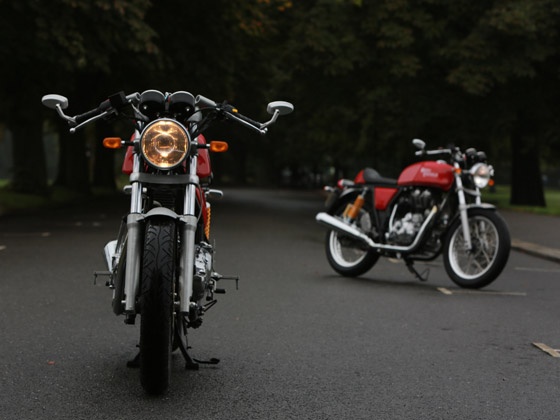
And on to the engine and the way we have learnt to experience Bullet calibre. Make no mistake this is in a different league though very mellow and even more enjoyable. I say this because there is a major churn in motorcycling the world over. Every bike maker and market has begun to seek easy going machines that are a joy to handle without in the least bit scaring the living daylights of the rider. I have always held that motorcycling is not about 200 miles per hour speeds to zero to warp speeds in three seconds and the world is beginning to understand that we do not need sophistication for the heck of it but meaningful technology to make do with less for more and in this case the Continental GT is right up there with the likes of Kawasaki, Honda and KTM who seem to be threading the same route with different individual takes as seen in the form of the Ninja 300, the CB500 and the 390 respectively. These three afford great control and ease of riding with a modicum of performance and with the right pricing to delight a wide swathe of bikers. The Continental GT wades right in there with them albeit with classic overtones and as much if not more enjoyment.
The 29 horses might not seem sufficient but I have learnt more than most that it is easy to get carried away by numbers rather than how much it makes me smile while out there on the road and in this test the Continental GT takes few prisoners. The first cog might a tad tall but once on the move the bike is nimble and responsive. A couple of bikes in the ride found the fuelling to be erratic but then this isn’t a bike to be revved and revved hard from cold given the lean burn combustion characteristic of the design. Yet on the move the bike seemed to have a strong torque flow and I think that with genuine performance close to 150km/h, this is one fleet Royal Enfield. Mind you the bike is best motoring at around the 130-135 km/h mark which she can do all day long but she definitely labours and wheezes while at it with the speedo needle nudging close to the 150 km/h mark. Make haste easily is the mantra with the Continental GT and she is happiest doing this. Mind you the lack of vibes was telling low down and in the mid-range and it was only when near the 5000rpm mark that the bike started buzzing through the levers and the seat. Maybe we need an Egli dose to up the motor’s capability to rev vibe free and yet get to do the proverbial ton – 100mph or 160km/h.
I liked the lightly weighted clutch action as well as the absolutely positive-shifting 5-speed gearbox though the super soft shifts could do with a bit of a mechanical detente to be felt. I did have a talk with the RE boffins on the fuelling and the softy-shift gearbox and while they were sad to hear about the latter, they did acknowledge the fuelling bit and one of the details being worked upon, at least for the European bikes, was to adopt a Power Commander to the bike and set it up accordingly. I am sure this could come to India as well if not as OE surely as an option.
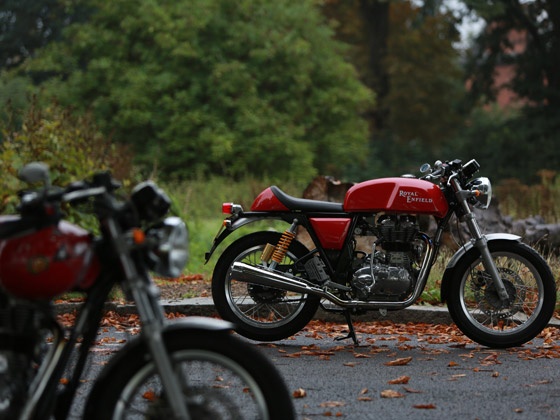
Brings me then to a host of options the bike has been designed with from the word go. The exhaust systems you see are the optional ones and the standard OE ones will appear when the bike goes on sale in India in early November. There will be a standard dual seat, the bikes in England sporting the nifty race-inspired single seat unit. There will also be a range of rear sets and mirrors plus a whole host of other mod cons as RE goes on ahead with the Continental on its GT trek. The carefully orchestrated launch was not just about the Continental GT but also about the experience around the bike and the whole bit about culture (design and style, biking mores of the 1960s era), craftsmanship (Lewis Leathers and the dazzling throwback of racing from cafe to cafe – hence the cafe racer theme) and history (Gordon Mays, the firm’s own resident historian no less introduced the new bike to the press at Brooklands along with Sid Lal) made a sensory assault that was all welcoming.
Where and how does it happen from here on
So what is the intent and how does it pan out from here is the obvious question to answer and you should get the bike from later this year in select showrooms. The main commercial launch is slated for November and bikes should be there for the taking at around Rs 2.25 lakhs for the standard version (no alloy wheels and without the sporty exhaust system seen here plus of course with a dual seat set-up). Overall the rest will remain the same including the suspension bits, the tyres, the style and the performance. Who will this bike appeal to has already been addressed and this includes a vast segment of the biker community across segments. Siddharth Lal put it best when he addressed the global motorcycle media and I would like to sign off this first report of the Continental GT with his words: “We believe there’s space for a different kind of motorcycling, something that’s not 150bhp, that doesn’t cost the earth, is tactile, fun at real world speeds and engaging.” Heck no one could have put it better!
From concept to reality
Auto Expo 2012 saw the first hint of a ‘performing’ Bullet when Royal Enfield showed off its take on the cafe racer theme (above). Cobbled up in good thought but poorly adorned, the concept nevertheless harked at the road for the company to travel on. It yet had the same Bullet frame with the engine being used as a stressed member while having newer suspension bits and a sporty single seat. The tank frankly was a disaster but in essence the form was just getting together. And the out-pouring of enthusiasts for such a sportily-oriented Bullet was tremendous and got Sid Lal and his team thinking about evolving the concept mightily.
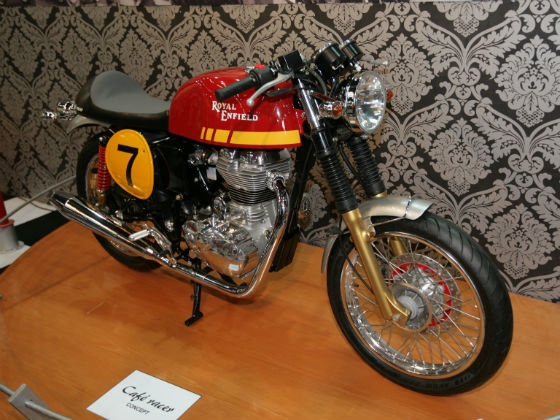
It took two years to get the packaging just right and Auto Expo 2012 was what turned up in very close form to the production version of the Continental GT (below). Even then the Continental GT name wasn’t even in sight or top of mind but the rest of the package was delectable. To have made the move from an idea to a supremely well crafted bike, yet in prototype form, was a joy and the response from show goers was the trigger to go ahead and engineer the machine for production. We couldn’t stop ourselves from applauding and willing it on! As our pics indicate, the bike displayed the overall form which has translated into the production machine though the cycle parts on the latter are way too high up the list and thoroughly welcome! This is a fantastic line of thought which is sure to pay massive dividends.
Continental GT story
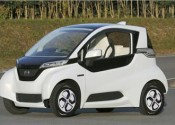

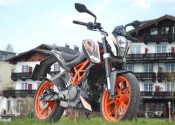
Leave a Reply